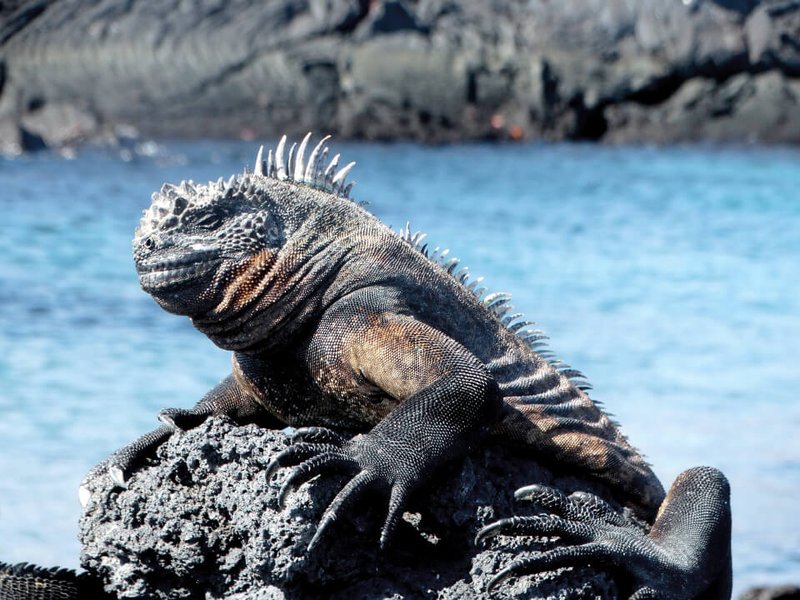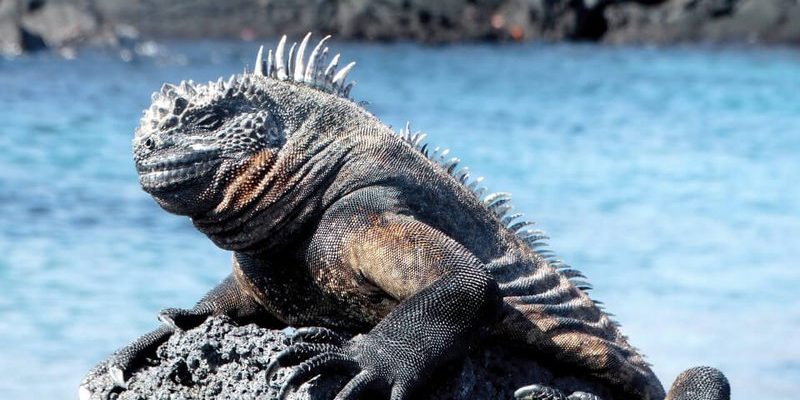
When we think about survival, we often picture the classic struggle of finding food or escaping predators. But for the marine iguana, it’s a whole other ball game. These lizards have developed unique features that let them feast on algae under the waves and handle the harsh conditions of their rocky homes. So, let’s dive into the incredible adaptations that not only help the marine iguana live but also thrive in its extraordinary habitat.
Unique Physical Adaptations
One of the most eye-catching traits of the marine iguana is its body shape. Unlike many other iguanas, the marine iguana is sleek and streamlined. This is not just for looks—this design helps them swim efficiently. Think about it: when you’re trying to slice through the water, being flat and agile makes a huge difference. Their long, flattened tails act as powerful paddles, propelling them through the ocean with grace.
Their claws are another interesting adaptation. Marine iguanas have sharp, curved claws that allow them to cling tightly to rocky surfaces while basking in the sun. This is crucial because these lizards need to dry off after swimming. Just imagine how awkward it would be to balance on a slippery rock! Their feet also help them navigate across uneven terrain, making them quite the agile little climbers.
Moreover, marine iguanas boast a unique coloration that serves a purpose. Their dark hues are perfect for absorbing sunlight, which helps them warm up after a chilly swim. This is especially important since they often dive into cold waters to feed on algae. So, in a way, their color isn’t just a fashion statement; it’s a survival tactic!
Feeding Adaptations
You might be wondering, “What do marine iguanas eat?” It’s pretty remarkable. These iguanas are primarily herbivores, with a diet mostly consisting of marine algae. They have evolved specialized teeth that are well-suited for grazing on this tough plant matter. The sharp edges of their teeth allow them to scrape algae off rocks with ease, making mealtime a little less of a chore.
Their foraging strategy is fascinating, too. Marine iguanas can hold their breath for up to an hour while swimming to find food. They dive into the waves, munching on algae, and then return to the surface to bask in the sun. The ability to stay underwater for extended periods is not just a cool party trick; it’s a vital part of their feeding behavior.
Another interesting aspect of their feeding is their ability to adapt to changes in food availability. When the seas are calm and algae are plentiful, they thrive. But if conditions change and food gets scarce, they can adjust their diet to include less nutritious options, showcasing their resilience and resourcefulness.
Behavioral Adaptations
Behavior plays a big role in the survival of the marine iguana. These creatures are known for their social behavior, often seen sunbathing in large groups. This isn’t just for comfort; basking together provides warmth and helps them regulate their body temperature after a chilly swim. It’s like having a little iguana community for warmth and safety!
When it comes to mating, marine iguanas have another interesting behavioral adaptation. Males will often engage in displays of strength and size to attract females. They puff themselves up and raise their heads, showing off their impressive size. This not only helps them stand out but also reduces the chances of physical altercations, which can be risky. Instead of fighting, they can put on a show—talk about a smart approach to dating!
Additionally, during breeding season, female iguanas will lay their eggs in burrows. This provides protection from predators and the harsh sun. The strategic digging of nests shows just how clever these iguanas can be in ensuring the survival of their young.
Adaptations to Cold Water
If you’ve ever jumped into cold water, you know how shocking it can be! Marine iguanas, however, have adaptations that allow them to thrive in the chilly waters off the Galápagos. Their ability to regulate body temperature is especially impressive. When diving, their bodies can cool down quickly; but when they return to land, they bask in the sun to warm up.
Additionally, they can shiver to generate heat, enabling them to maintain their body temperature even after extensive swimming in cold currents. Just think of it as their version of putting on a cozy sweater after a dip in the pool.
Another cool feature is their blood circulation. When they’re cold, their bodies can redirect blood flow to vital organs, conserving heat. This circulation adaptation is key in helping them survive in a habitat that’s not always warm and welcoming.
Dealing with Predators and Threats
Like all living creatures, marine iguanas have their fair share of threats. They face predators like hawks, snakes, and even humans. To counteract these dangers, marine iguanas exhibit a few clever adaptations. One of the most notable is their ability to dive and hide when they sense danger. They can quickly slip into the water, becoming much harder to spot.
Another defensive adaptation is their coloration. The darker shades help them blend into the rocks and seaweed, providing some camouflage against predators. Just like wearing the right outfit for a party can help you fit in, their skin color helps them avoid being seen.
Let’s not forget their incredible resilience. Marine iguanas can tolerate the saltwater in ways many other reptiles can’t. They have specialized glands that excrete excess salt. This means they can drink seawater when they absolutely need to, which is a huge benefit in their arid environment. It’s like having a secret survival hack available at all times!
Conservation and Future Challenges
Despite their unique adaptations, marine iguanas aren’t invincible. Environmental changes, such as climate change and ocean warming, pose significant threats to their survival. As their habitat shifts, food sources may become limited, and their ability to adapt could be tested. It’s crucial to keep these creatures in mind as we consider our impact on the planet.
Conservation efforts are underway to protect marine iguanas and their habitats. By understanding the challenges they face, we can support measures that help preserve these enchanting reptiles. Education and awareness are key to ensuring that future generations can marvel at the marine iguana’s extraordinary adaptations and resilience.
The marine iguana is a true testament to nature’s creativity and adaptability. From their unique physical traits to their clever feeding strategies and social behaviors, these reptiles showcase a remarkable story of survival. They remind us that even in challenging environments, life can flourish with the right adaptations in place. As we explore the wonders of the natural world, let’s appreciate the resilience of creatures like the marine iguana, ensuring they continue to thrive for years to come.

